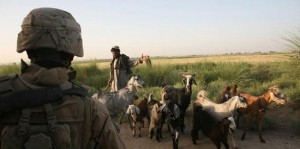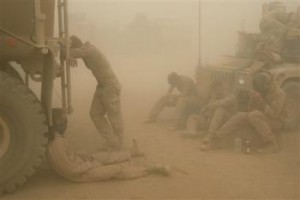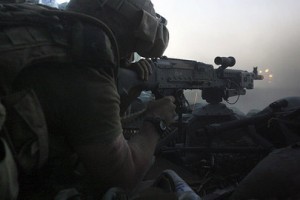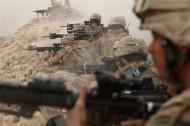Marines in Helmand IV
BY Herschel SmithReport (from the New York Times)
United States marines pushed the Taliban out of this village and the surrounding district in southern Helmand Province so quickly in recent weeks that they called the operation a “catastrophic success.”
Yet, NATO troops had conducted similar operations here in 2006 and 2007, and the Taliban had returned soon after they left. The marines, drawing on lessons from Iraq, say they know what to do to keep the Taliban at bay if they are given the time.
“There is definitely someone thinking out there,” said Capt. John Moder, commander of Company C of the 24th Marine Expeditionary Unit, speaking of the Taliban. “That’s why we need these people to be at least neutral to us,” he said, gesturing to the farmers who have been slowly filtering back to harvest their fields.
Originally sent to Garmser District on a three-day operation to open a road, the marines have been here a month and are likely to stay longer. The extension of the operation reflects the evolving tactics of the counterinsurgency effort in Afghanistan, building on the knowledge accumulated in recent years in Anbar Province in Iraq.
The district of Garmser, a fertile valley along the Helmand River, had been under control of the Taliban and members of Al Qaeda for most of the last two years and much of it had become a war zone, as the Taliban traded fire with British troops based in the district center. One of the largest poppy-growing areas in the country, Garmser District has been an important infiltration route for the insurgents, sending weapons and reinforcements to the north and drug shipments to the south to the border with Pakistan.
Previous operations by NATO forces to clear the area of Taliban had yielded short-lived successes, as the Taliban have re-established control each time, Afghans from the area said. It is a strategy the insurgents have employed all over Afghanistan, using roadside and suicide bombs as well as executions to terrorize the people and undermine the authority of foreign forces and fledgling local governments.
In Garmser those with the means gave up and fled to the provincial capital, Lashkar Gah. Interviewed there by telephone, they said they had been living as refugees for almost two years and were still afraid to return — and to be identified, for fear of retribution from the Taliban.
But Company C served in Anbar Province, once one of the most intractably violent areas of Iraq, which quieted last year under a new strategy of empowering local groups called Awakening Councils, which now provide security. The marines were confident they could put that experience to good use here.
Only when you win over a critical balance of the local population and empower them to stand up to the insurgents can you turn the situation around, several marines said.
First Lt. Mark Matzke led a platoon for nine months last year in the Anbar city of Ramadi, where he said he got to know every character in a small neighborhood, both the troublemakers and the power brokers. But it was only when he sneaked in after dark and listened to people’s grievances in private that he was able to work out a strategy for protecting them from the insurgents.
“Through listening to their grievances, you could figure out that the people did not like the insurgents,” he said. But their biggest fear was that the marines would pull out, he said, leaving them at the mercy of insurgents who would treat them as collaborators.
As trust was built up, the people began to side with the marines and started to tip them off about who the insurgents were and where to find them. “You just need to give them confidence,” he said.
In this village, only the poorest laborers and farmers have started filtering back, Lieutenant Matzke said, adding, “These people are completely broken.” They refused all assistance at first, he said, but after talking for a couple of hours they admitted they could use the help, but were afraid to accept it for fear of the Taliban.
The people were glad when the Taliban were driven away, the marines said, and that is a sentiment they need to nurture. “We need to convince the people we are here to help, and to exploit the fact that we can help,” Captain Moder said.
As a first step, the marines promised to provide a strong security cordon so those villagers who had fled could return without fear to rebuild their homes and reopen the bazaar.
When on patrol, the marines carry a small gadget the size of an old Polaroid camera that takes fingerprints, photos and an iris scan of people they meet. It is used to build a database of the residents so they can easily spot strangers, the marines say. The Afghans accepted the imposition without protest.
Observation on the ground, information from the populace and control of key commerce and transportation routes are all ways to prevent the Taliban from seeping back into the area, Col. Peter Petronzio, commander of the 24th Marine Expeditionary Unit, said in an interview.
“You need physically to be there,” he said. “You need to continue to move about the population, let your presence be known, but do it in a way so that you are not smothering and overwhelming. You have got to let life go on.”
But the villagers remain scared, uncertain how long the marines will stay and who will follow in their wake.
“I don’t think I will go back until complete peace and security comes,” said one elder, who said he had heard his house had collapsed under bombardment. “This is not the first time we have suffered. Several times we have seen such operations against the Taliban, and after some time the forces leave the area and so the Taliban find a way to return.”
“If NATO really wants to bring peace and make us free from harm from the Taliban,” he said, “they must make a plan for a long-term stay, secure the border area, install security checkpoints along the border area, deploy more Afghan National Army to secure the towns and villages, and then the people will be able to help them with security.”
Analysis & Commentary
The statement about Anbar being quieted by empowering local groups is a bit of a dumbed down version of the Anbar campaign, and doesn’t do justice to the kinetic fight against both al Qaeda and the Sunni insurgency. It also doesn’t do justice to the fight between the Sunni insurgency and al Qaeda even before being empowered by the U.S. (much later in the campaign). Its continual repetition implies that all NATO has to do is have a few meetings with tribal elders and arm their sons, and the Taliban problem will suddently be over. It is doltish.
The Sunnis in Anbar are stubborn people (according to Iraqis with whom we have spoken), and much more secular that the al Qaeda jihadists who flooded from across the globe to fight (Shiekh Abdul Sattar abu Risha was a chain smoker). Al Qaeda’s brutality, U.S. kinetic operations, relationships built with tribal leaders (viz. Captain Travis Patriquin), a string of combat outposts in Ramadi, biometrics and gated communities in Fallujah, sand berms around Haditha, and a complex puzzle of other factors made up the campaign in Anbar. The Anbar narrative is too complex to throw a few words at it in an article about Afghanistan. If a journalist cannot draw this out in a single article, they s/he shouldn’t try.
Nonetheless, security does play a premier role in the discussion above, and in earlier reports about the Marines in Helmand it had been stated that the Marines were to continue through Afghanistan on a NATO command wish list of chores. Apparently the idea of secure, hold and build has dawned on command and they are allowing the Marines to stay as they should.
It’s just not correct to say that the COIN tactics are evolving in Afghanistan. U.S. Army units have been at combat outposts for quite a while, and the Marines are simply conducting well-rehearsed and finely-tuned COIN learned in the school of hard knocks in Anbar. For the most part NATO forces are still conducting force protection at FOBs, with each country’s forces undermanned. As for evolving tactics, there is no comprehensively agreed to strategy or set of tactics or even rules of engagement; there is merely an aggregate of disparate missions and strategies thrown together into a messy brew.
It is interesting that biometrics is being used – albeit on a small scale – in a tip of the hat to Operation Alljah. Without biometric and census data the Marines won’t know who is who, and without the Marines, biometric data is useless.
The people have spoken to let us know what will be necessary to return en masse to their homes and rebuild society. Security. It is a theme we have discussed before, and shows once again that long term force projection is required.
Finally, it really is annoying to see ‘marines’ misspelled (a capital M should be used), and since the article is not discussing marine life in the sea and the spelling rules are fairly simple, it is profoundly poor that this kind of mistake continually makes it through journalists and editors.
Prior: Marines in Helmand








